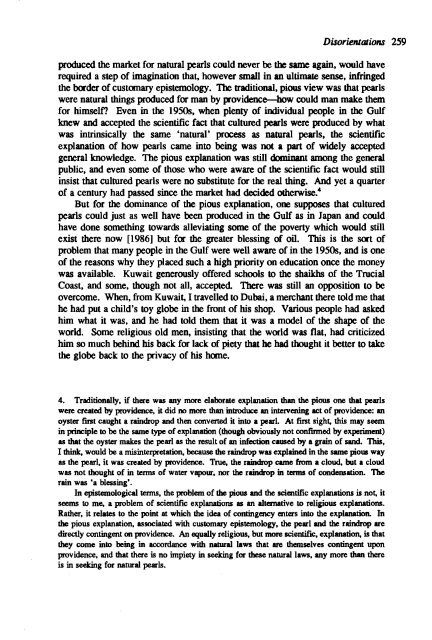1991 No. 1 CONTENTS - Institute of Social and Cultural ...
1991 No. 1 CONTENTS - Institute of Social and Cultural ...
1991 No. 1 CONTENTS - Institute of Social and Cultural ...
You also want an ePaper? Increase the reach of your titles
YUMPU automatically turns print PDFs into web optimized ePapers that Google loves.
Disorienllllions 259<br />
produced the market for natural pearls could never be the same again, would have<br />
required a step <strong>of</strong> imagination that, however small in an ultimate sense, infringed<br />
the 1xx'der <strong>of</strong> customary epistemology. The traditional, pious view was that pearls<br />
were natural things produced for man by p-ovidence--how could man make them<br />
for himself] Even in the 1950s, when plenty <strong>of</strong> individual people in the Gulf<br />
knew <strong>and</strong> accepted the scientific fact that cultured pearls were produced by what<br />
was intrinsically the same 'natural' process as natural pearls, the scientific<br />
explanation <strong>of</strong> how pearls came into being was not a part <strong>of</strong> widely accepted<br />
general knowledge. The pious explanation was still dominant among the general<br />
public, <strong>and</strong> even some <strong>of</strong> those who were aware <strong>of</strong> the scientific fact would still<br />
insist that cultured pearls were no substitute for the real thing. And yet a quarter<br />
<strong>of</strong> a century had passed since the market had decided otherwise:'<br />
But for the dominance <strong>of</strong> the pious explanation, one supposes that cultured<br />
pearls could just as well have been produced in the Gulf as in Japan <strong>and</strong> could<br />
have done something towards alleviating some <strong>of</strong> the poverty which would still<br />
exist there now [1986] but for the greater blessing <strong>of</strong> oil. This is the sm <strong>of</strong><br />
problem that many people in the Gulf were well aware <strong>of</strong> in the 19508, <strong>and</strong> is one<br />
<strong>of</strong> the reasons why they placed such a high priority 00 education once the money<br />
was available. Kuwait generously <strong>of</strong>fered schools to the shaikhs <strong>of</strong> the Tmcial<br />
Coast, <strong>and</strong> some, though not all, accepted There was still an opposition to be<br />
overcome. When, from Kuwait, I travelled to Dubai, a merchant there told me that<br />
he had put a child's toy globe in the front <strong>of</strong> his shop. Various people had asked<br />
him what it was, <strong>and</strong> he had told them that it was a model <strong>of</strong> the shape <strong>of</strong> the<br />
world. Some religious old men, insisting that the world was flat, had criticized<br />
him so much behind his back for lack <strong>of</strong> piety that he had thought it better to take<br />
the globe back to the p-ivacy <strong>of</strong> his home.<br />
4. Traditionally, if there was any more elaborate explanation than the pious one that pearls<br />
were created by providence, it did no more than introduce an intervening act <strong>of</strong> providence: an<br />
oyster first caught a raindrop <strong>and</strong> then converted it into a pearl. At first sight, this may seem<br />
in principle to be the same type <strong>of</strong> explanation (though obviously not confirmed by experiment)<br />
as that the oyster makes the pearl as the result <strong>of</strong> an infection caused by a grain <strong>of</strong> s<strong>and</strong>. This,<br />
I think, would be a misinterpretation, because the raindrop was explained in the same pious way<br />
as the pearl. it was created by providence. True, the raindrop came from a cloud, but a cloud<br />
was not thought <strong>of</strong> in terms <strong>of</strong> water vapour, nor the raindrop in terms <strong>of</strong> condensation. 'The<br />
rain was la blessing'.<br />
In epistemological terms, the problem <strong>of</strong> the pious <strong>and</strong> the scientific explanations is not, it<br />
seems to me, a problem <strong>of</strong> scientific explanations as an alternative to religious explanations.<br />
Rather, it relates to the point at which the idea <strong>of</strong> contingency enters into the explanation. In<br />
the pious explanation. associated with customary epistemology, the pearl <strong>and</strong> the raindrop are<br />
directly contingent on providence. An equally religious, but more scientific, explanation, is that<br />
they come into being in accordance with natural laws that are themselves contingent upon<br />
providence, <strong>and</strong> that there is no impiety in seeking for these natural laws, any more than there<br />
is in seeking for natural pearls.
















